Scottish Crime and Justice Survey 2017/18: main findings
Main findings from the Scottish Crime and Justice Survey 2017-18 and the self-completion findings covering the period 2016-17 to 2017-18.
This document is part of a collection
8. SCJS topical reports
In addition to exploring the extent and prevalence of crime, and perceptions of the police, criminal justice system and crime more generally, the SCJS also collects data on a range of other justice related topics.
In recognition of the level of interest in the topic, the following section first provides an overview of the evidence available through the SCJS on cyber-crime and an update on wider developments being taken forward by the Scottish Government and others on this topic.
It then presents key findings from the 2017/18 SCJS on:
8.1 Cyber-crime in Scotland
What is cyber-crime?
Defining cyber-crime is complex and there is not an agreed upon definition. The main debate centres around the extent to which cyber technology[80] needs to be involved for the crime to be termed ‘cyber-crime’. For the purposes of the SCJS and this topical report, a broad definition of cyber-crime is adopted that includes crimes in which cyber technology is in any way involved. This ranges from offences which would not be possible without the use of cyber technology (such as the spreading of computer viruses) to those with a more minor cyber element involved (such as uploading a video of a crime to the Internet).
This chapter therefore presents results available from the SCJS on the extent to which cyber technology is involved in a wide range of offences. The section below presents SCJS results relating to online experiences of violent crime, fraud (including perceptions of fraud and indicative findings on the extent of some types of fraud), the sale of fake/smuggled goods, the sourcing of drugs and stalking/harassment.
It then briefly highlights findings from other recent publications that add to this picture of cyber-crime, such as the Scottish Government’s Cyber Crime Evidence Review, the Crime Survey for England and Wales (CSEW) and police recorded crime. Finally, it outlines the new questions on cyber-crime that were developed with users and added to the 2018/19 SCJS, which will be reported on in future years.
As the following summary of cyber-related SCJS findings brings together data from different sections of the survey, base sizes and variable names are generally provided in the footnote to highlight the survey questions which relevant findings are derived from.
To what extent was crime occurring online in 2017/18?
The SCJS does not find that many ‘traditional’ crimes happen online, however this is likely due to the questions currently asked.
The SCJS currently asks respondents who have been victims of crime where these crimes happened, with ‘online/via the Internet’ as a possible response. In 2017/18, as with previous years, no respondents selected online/via the Internet as the best description of where a crime happened[81]. This is likely due to the survey’s focus on victims of violent and property crime.
However, cyber elements may be involved in ‘traditional’ crimes in other ways, such as researching how to commit or conceal a crime. To enable the SCJS to examine the proportion of property and violent crime picked up by the survey that has a cyber element, a ‘cyber flag’[82] has been added to the 2018/19 survey. A similar approach is currently used by the CSEW, to show in their latest findings that 3.6% of robberies, 0.2% of theft offences and 0.1% of criminal damage incidents were flagged as being cyber-related in the year ending March 2018[83]. The first results from the SCJS cyber flag will be included in the 2018/19 Main Findings report.
In the meantime, other questions in the SCJS do indicate some involvement of cyber technology in several types of ‘traditional’ crime. The following sections present these findings related to violent crime, fraud, the selling of fake/smuggled goods, the sourcing of drugs, and stalking and harassment.
What role is cyber technology playing in violent crime?
A small proportion of violent crime was recorded in 2017/18, but no victims of these crimes reported being aware of these recordings being distributed online.
The SCJS asks respondents if, in the year prior to interview, they have been victims of violent crime. It then asks respondents who have been victims of violent crime whether the crime was recorded and if they know of it being distributed online (such as the Internet, social networking sites or email).
In 2017/18, 12% of violent crimes experienced by adults were recorded, for instance on a mobile phone or camera, or by CCTV, unchanged from 2016/17. However, no respondents reported being aware that this recording was distributed online[84].
It should be noted that the SCJS can only capture instances where the victim is aware that recordings of violent crime have been distributed online. As such, this finding cannot pick up all cases of violent crime recordings being distributed online.
What can the SCJS tell us about experiences of and concerns about fraud[85] in 2017/18?
Indicative findings suggest that in 2017/18 5% of adults had their credit/bank card details stolen and 1% had their identity stolen, however the extent of cyber involvement is unknown.
The SCJS is currently unable to provide robust estimates on the volume or prevalence of fraud, however it does capture some evidence on people’s experiences of certain types of fraud, in the form of ‘Victim Form Screener’ questions[86], as well as their perceptions of fraud. These screener questions provide indicative findings only, as respondents are not asked for full details of the incidents that would enable them to be coded into valid/invalid[87] SCJS crimes in the way that they are with other ‘traditional’ SCJS crime incidents.
Notwithstanding these caveats, analysis shows that 5% of adults reported that they had their credit or bank card details used fraudulently in the 12 months prior to interview in 2017/18[88]. This is unchanged from 2016/17 but has increased from 3.6%[89] in 2008/09.
Identity theft was less common, with 1% of adults reporting experiences of such incidents in 2017/18, unchanged from both 2016/17 and 2008/09.
Although these findings are only indicative, it is notable that the CSEW finds relatively similar results on prevalence using a more expansive set of questions added in recent years to robustly capture experiences of fraud (and computer misuse). The latest figures for the year ending September 2018[90] show an estimated 3.5 million incidents of fraud were experienced by 6.3% of adults in England and Wales. The CSEW questions also capture the extent to which cyber technology is involved in these incidents, finding that over half (56%) of fraud incidents were cyber-related, amounting to approximately 1.9 million incidents.
As in recent years, respondents in 2017/18 were most likely to report being worried about acts of fraud, as well as thinking these were likely to happen to them in the next year, compared to other types of crime.
The SCJS also asks respondents which crime types they worry about happening or think are most likely to happen to them.
In 2017/18, 51% of adults in Scotland were worried about their bank/credit card details being used to obtain money, goods or services[91]. As with other years, the next most worried about crime type was identity theft[92] with 43% of adults worrying about this type of fraud in 2017/18. Levels of worry about these two types of fraud were higher than for all other crime types asked about in 2017/18. Looking over time, worry about both types of fraud has fallen since 2008/09 but has not shown any change since 2016/17.
As with previous years, worry about both of these fraudulent acts in 2017/18 varied by demographic characteristics. For example, women were more likely to be worried about fraud (54% worried about their credit or bank details being used fraudulently, 44% worried about identity theft) than men (47% credit or bank details, 41% identity theft).
In 2017/18, half of respondents (52%) did not think it was likely that they would experience any of the crimes listed in the next 12 months. However, the crime type respondents most commonly thought would happen to them was someone using their credit card/bank details fraudulently (26%). As with worry about crime, this was followed by people thinking their identity will be stolen (16%). The perceived likelihood of both of these types of fraud happening was unchanged from 2016/17, but has increased from 2008/09 and 2014/15.
It is interesting to note that while the perceived likelihood of becoming a victim of fraud has increased over time, worry about fraud has decreased over the same period.
Figure 8.1: Proportion of adults concerned about fraud and identity theft, 2008/09 to 2017/18
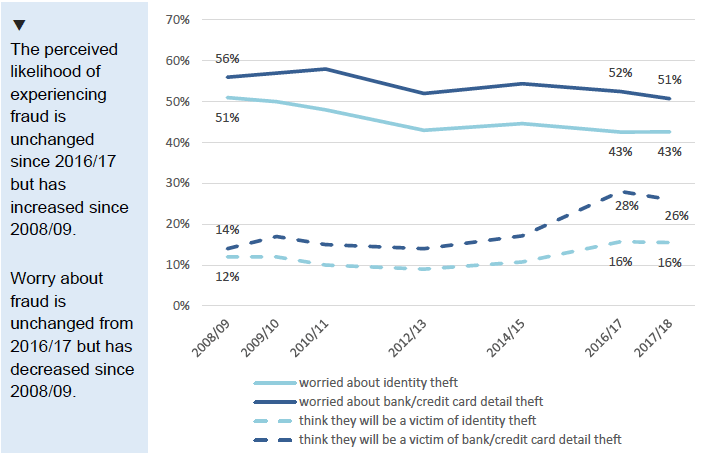
Base: All adults - SCJS 2008/09 (16,000); 2009/10 (16,040); 2010/11 (13,010); 2012/13 (12,050); 2014/15 (11,470); 2016/17 (5,570); 2017/18 (5,480).
Unlike findings in previous years, there was no difference in perceived likelihood of being a victim of fraud between women and men[93]. However, people living in the 15% most deprived areas of Scotland were less likely (19%) than respondents in the rest of Scotland (27%) to think that their credit/bank card details would be used to fraudulently buy goods/services in the next year.
To what extent was the internet involved in the selling of fake/smuggled goods and the sourcing of drugs?
The selling of fake or smuggled tobacco/cigarettes was more likely to take place via ‘traditional’ means than on the internet.
The SCJS asks respondents a series of questions about fake/smuggled goods.
In the year prior to interview, the vast majority of adults (84%) said they were not offered any of the fake and/or smuggled goods asked about. The most common fake or smuggled goods offered in 2017/18 were cigarettes/tobacco (7%), whilst just under one-in-twenty adults (4%) said they had been offered fake or smuggled clothes[94].
Just under one-in-twenty those offered fake or smuggled cigarettes/tobacco in 2017/18 (6%), said it occurred ‘on the internet’[95], unchanged from 2016/17. Findings on fake and smuggled goods more generally are covered by a later section of this report.
The SCJS finds that more traditional methods of obtaining drugs continue to dominate, but a small proportion of ‘legal highs’ are sourced via the internet.
The SCJS asks respondents about their use of illicit drugs and ‘legal highs’, including how they source these drugs.
In 2017/18, no SCJS respondents who reported using drugs in the last month reported sourcing their most frequently used substance online[96]. This is unchanged from 2014/15[97]. In contrast, 44% got the drug from someone outwith their family who is well known to them (the most common response), whilst 16% said they obtained it from a known dealer. 5% reported getting the drug from a shop.
The SCJS also asks respondents who have ever taken ‘legal highs’[98] who or where they got them from. It was found that 8% of adults who had ever taken ‘legal highs’ sourced these from the internet[99]. This compares to 52% who got the drug from someone outwith their family who is well known to them and 31% who got the drug from a shop.
The SCJS may find that a greater proportion of ‘legal highs’ than ‘traditional’ drugs are sourced online due to differences in how these questions are asked. Respondents are asked about their most frequently used ‘traditional’ drug and are asked about the sourcing of this drug in the last month, whereas the ‘legal highs’ asked about are not necessarily the most frequently used substance and need not have been taken in any specific time period.
Alternatively, these findings may reflect differing patterns in availability and sourcing across different types of substances, users and suppliers.
To what extent were people insulted or harassed online?
The SCJS asks respondents about their experiences of being stalked or harassed in various terms. Firstly, as part of the main survey it asks if they have been insulted, pestered or intimidated in any way by someone outwith their household in the year prior to interview.
Later, within the self-completion element of the survey, it asks if they have experienced any of the following behaviours more than once: the sending of unwanted letters or cards; sending of unwanted messages by text, email, messenger or posts on social media sites; receiving unwanted phone calls; loitering outside their home or workplace; being followed; and/or having intimate pictures of them shared without consent, for example by text, on a website, or on a social media site.
In person experiences of being insulted, pestered or intimidated continue to be much more common than those carried out in writing via electronic means.
In 2017/18 14% of adults were insulted, pestered or intimated in any way by someone outwith their household. This was unchanged from 2008/09 and 2016/17[100]. More findings on harassment in general are reported in the later section on harassment and discrimination.
Of those who experienced this, 16% encountered such behaviour ‘in writing via text, email, messenger or posts on social media’ (unchanged from 2016/17[101]), compared to 84% who experienced incidents in person in 2017/18.
Repeated incidences of stalking and harassment are most commonly experienced by electronic means, including online.
The SCJS also collects data on arguably more severe examples of stalking and harassment. In 2016/18[102], 11.1% of adults had experienced at least one form of stalking/harassment as defined by the SCJS in the 12 months prior to interview. Changes to the stalking/harassment questions in 2016/17 mean that these figures cannot be directly compared to previous years.
Of those who experienced one or more of the kinds of stalking/harassment given on the list in 2016/18, 67% of people experienced this in the form of unwanted messages by text, email, messenger or posts on social media sites. New data collected in 2016/18 also found that 4% of those experiencing stalking/harassment reported someone sharing intimate pictures without their consent[103].
Widening the focus: How does wider analytical work complement the evidence provided by the SCJS on cyber-crime?
A number of recently published strategies emphasise the challenges and risks of cyber-crime, including Scottish Government’s Justice Vision and Priorities, its Cyber Resilience Strategy and Policing 2026.
To inform this on-going strategic work, a range of analytical work is being carried out with the aim of developing the evidence base around cyber-crime. The sections below highlight where the Scottish Government’s Cyber Crime Evidence Review, the Crime Survey for England and Wales and Police Scotland’s cyber marker can tell us more about the involvement of cyber technology in sexual crimes, computer misuse and police recorded crime.
Sexual crimes in the Scottish Government’s cyber-crime evidence review
While the SCJS provides evidence on the prevalence of sexual victimisation in Scotland, the survey does not currently collect data which enables an assessment of whether sexual crimes involved an online element.
The Scottish Government recently published an evidence review of cyber-crime, exploring existing evidence (such as the SCJS, CSEW and recorded crime data) and literature in order to assess the scale, nature and impact of cyber-crime on individuals and businesses in Scotland.
This review includes reference to research undertaken by Scottish Government analysts which studied a sample of police records from 2013/14 and 2016/17 and included consideration of the influence of cyber technology on sexual crime in Scotland[104]. This research found that both the scale and nature of sexual crime has been impacted by cyber technology in Scotland in recent years. For example:
- The research estimated that a rise in cyber enabled 'other sexual crimes' has contributed to around half of the growth in all police recorded sexual crimes in Scotland between 2013/14 and 2016/17.
- It is estimated that the internet was used as a means to commit at least 20% of all sexual crimes recorded by the police in 2016/17.
- When the specific 'other sexual crimes' of 'communicating indecently' and 'cause to view sexual activity or images' are cyber-enabled, victims and offenders tend to be younger (three-quarters of victims aged under 16 and more than half of offenders under 20) and are more likely to know of one another.
Computer misuse and fraud in the Crime Survey for England and Wales
The current SCJS questions do not collect data on incidents of computer misuse[105], nor do they collect indicative findings on the prevalence of this crime like those collected on fraud.
The Crime Survey for England and Wales (CSEW) has developed and included a substantial module to robustly capture experiences of fraud and computer misuse since October 2015. The questions provide estimates on the incidence, prevalence and nature of these crimes and also the proportion of fraud and computer misuse incidents that are cyber-related.
Findings from the year ending September 2018[106] show that an estimated 1 million incidents of computer misuse were experienced by 1.8% of adults in England and Wales. The vast majority (93%) of computer misuse incidents were cyber-related.
The SCJS team is in regular contact with CSEW counterparts about the development and implementation of cyber related questions. While we cannot and do not use crime data from other countries to predict underlying crime trends in Scotland, there is no reason to necessarily expect that the extent of computer misuse would be markedly different in Scotland. This is especially true given that the CSEW findings on the prevalence of fraud are relatively similar to those in the SCJS, as noted earlier.
Recorded crime from Police Scotland’s cyber marker
Since the introduction of cyber-crime markers on crime recording systems in April 2016, Police Scotland has continued to develop its marking practices across other Police Scotland recording systems and databases. This activity is being undertaken by the Cybercrime Capability Programme under Police Scotland’s ‘Policing 2026 Strategy’. As this marker becomes fully embedded across Police Scotland systems, it should provide a valuable evidence source of police recorded crimes involving a cyber-element.
Police forces in England and Wales have also had to report on the proportion of crimes occurring online, either fully or partially, since 2015. The latest police recorded crime findings from the Home Office show that 49% of obscene publications, 32% of blackmail, 16% of child sexual offences and 15% of stalking and harassment were flagged as cyber in the year ending September 2018[107].
Developing the cyber-crime evidence base: Future SCJS questions
As previously mentioned, a ‘cyber flag’ question was added to the SCJS in 2018/19 in the victim form section of the questionnaire. This is a similar approach to that adopted by the CSEW and will enable us to examine the proportion of property and violent crime (currently included in the SCJS) that involves a cyber-element. The first findings from these questions will be available in the 2018/19 SCJS Main Findings report.
In addition to this, the 2018/19 SCJS questionnaire contains a new set of cyber-crime questions that cover people’s experiences of specific cyber-crime activities, the impact/harm resulting from experience, resulting changes in online behaviours and reporting of cyber-crimes. These questions were developed in conjunction with stakeholders and been cognitively tested.
The findings from these new cyber-crime questions will not be included in the main SCJS crime estimates, however they represent an important step in developing the cyber-crime evidence base in Scotland. This will help to improve our understanding of experiences amongst the population and also identify future priorities in terms of action and evidence needs.
More information, including the areas the questions cover, is available in the SCJS 2018/19 Questionnaire Review Paper.
8.2 Focus on harassment and discrimination
The following section presents national level findings on experiences of harassment and discrimination. In line with the general SCJS reporting structure agreed with SCJS users, these results are not broken down within the report for population sub-groups as these findings are based on questions asked to one-quarter of the overall sample. However, breakdowns for demographic and area characteristics are provided in the 2017/18 SCJS data tables.
The SCJS asked respondents whether they had experienced any incidents in which they were insulted, pestered or intimidated in any way (in person or some other means[108]) by someone outwith their household in the year prior to interview[109]. Additional information on other experiences of stalking and harassment are captured in the self-completion element of the SCJS and reported on in a later section of this report, with the below summary focusing on key findings on this topic from the main (face-to-face) survey.
How common were experiences of harassment in Scotland in 2017/18?
Most adults did not experience any form of harassing or intimidating behaviour in 2017/18.
In 2017/18 such experiences were reported by 14% of adults, similar to the proportion of respondents who were victims of such incidents in 2008/09 and 2016/17.
What can the SCJS tell us about the nature of harassment experienced?
Experiences of harassment in 2017/18 generally took place in person, with verbal abuse the most common behaviour encountered.
Looking at details provided by victims on their experience of harassment in 2017/18 (n=168) reveals that:
- the vast majority (84%) encountered some sort of issue ‘in person’, whilst only 16% reported that they were insulted, pestered or intimidated in writing ‘via text, e-mail, messenger or posts on social media’. This suggests that electronic communication does play a role in a proportion of harassment incidents, although ‘offline’ experiences remain much more common[110].
- most of those affected said they had experienced harassing behaviour on more than one occasion over the year with 37% reporting only one incident. One-in-five (20%) victims of harassment reported experiencing harassing behaviour on more than ten occasions or too many times to remember in the previous year.
- verbal abuse was the most common type of harassment experienced in 2017/18 – reported by 81% of victims. Other types of harassment, particularly those involving physical contact, were much less commonly experienced - each form of behaviour suffered by around one-in-ten victims as shown in Figure 8.2[111].
Figure 8.2: Proportion of harassment victims experiencing different kinds of behaviour in previous 12 months
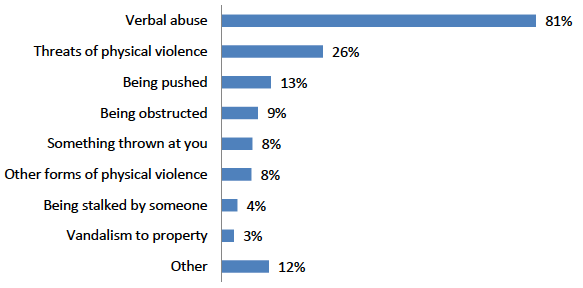
Base: All respondents who had been insulted, pestered or intimidated in previous 12 months (170); Variable: QHWHAT2
Most experiences of harassment were not perceived to have any particular motivating factor.
In order to explore whether incidents may have been related to discrimination, respondents who experienced harassment in 2017/18 were asked whether they thought any particular (perceived or actual) characteristic they hold may motivated the offender in any encounters. The proportions citing a range of possible reasons in relation to their most recent (or only) experience are outlined in Figure 8.3.
It shows that one-in-ten victims of harassment (10%) thought that their gender, gender identity or perception of this was a possible motivating factor, with 9% believing their ethnic origin or race was an influence. Around two-thirds of harassment victims in 2017/18 (63%) did not think any of their characteristics were an influencing factor in their most recent experience.
Figure 8.3: What respondents thought their most recent (or only) experience of harassment in last year was or may have been motivated by
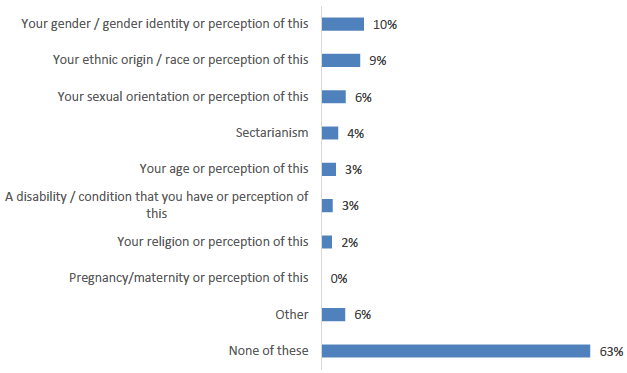
Base: All respondents who had been insulted, pestered or intimidated in previous 12 months (170). Variable: QHDISCRIM1
8.3 Focus on workplace abuse
What was the extent and nature of abuse experienced by adults employed in public facing roles in Scotland?
This section considers the experiences of adults in Scotland who spend time dealing with the general public while at work. The 2017/18 SCJS estimates that around three-quarters (73%) of adults in employment spent some time dealing with the general public during the course of their work, either face-to-face or over the telephone.
Most adults did not experience abuse when dealing with the public while at work in 2017/18. Of those who did, verbal abuse (34%) was more common than physical abuse (4%).
As shown below in Figure 8.4, most adults did not experience verbal or physical abuse when dealing with the public while at work in 2017/18 (66%). However, when abuse was encountered, verbal abuse was more common than physical abuse. In 2017/18, of those who dealt with the public at work, it is estimated that 34% of adults had experienced verbal abuse compared to 4% of adults who had experienced physical abuse.
These results from the 2017/18 on workplace abuse are similar to the results of the 2008/09 SCJS (when these questions were first included), as demonstrated in Figure 8.4. Each of the apparent differences are not statistically significant[112].
Figure 8.4: Proportion of adults who have contact with the public at work who experienced abuse while dealing with the general public
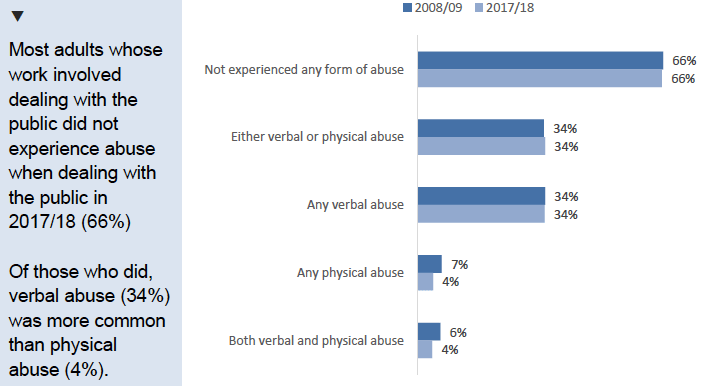
Base: Verbal abuse: adults who have contact with the public at work (2008/09: 1,530; 2017/18: 530). Physical abuse and either/both: adults who have face to face contact with the public (2008/09: 1,390; 2017/18: 490). Variables: QDVERB; QDPHYS.
The relatively low prevalence of physical abuse in the 2017/18 SCJS means that no further analysis of physical abuse at work is possible in this chapter. However, the ‘Focus on violent crime’ chapter includes information on violent crimes, including those experienced at work. This shows that in or near the place of work (28%) was the option most frequenctly selected by respondents in 2017/18 when they were asked about the location of the incident.
Further analysis is possible in this chapter on the circumstances of those who experienced verbal abuse while at work while dealing with the public[113].
- Just under a third of adults (32%) experiencing verbal abuse from the general public at work said they experienced at least one verbal abuse incident per week, similar to 2008/09. 7% reported experiencing verbal abuse every day.
- 45% of adults who had experienced verbal abuse said they did not report the latest incident to their employer. The most common reasons for not reporting verbal abuse to their employer were “incidents such as these are just part of the job” (68%) and “it’s not worth the bother” (30%).
- 65% of adults who experienced only verbal abuse said their last incident occurred during the week with 26% of incidents occurring at the weekend. The most common time of day to experience verbal abuse during the week was between noon and 6pm (33%)
- Of those who had experienced this type of abuse at work, 7% said it was or may have been motivated by their ethnic origin / race (or perception of this) and 6% said it was motivated by their gender. Most people said it was not motivated by any of the following reasons, their: ethnic origin, religion, sectarianism, gender, disability, sexual orientation or age (79%).
Most adults were not worried about experiencing workplace abuse, however a small proportion worried a lot about this.
Eighty-nine per cent of all employed adults said they did not worry much or at all about verbal or physical abuse happening at work. Two per cent of adults worried a lot, and 9% worried a little about it. Similar results are found when looking at only those adults employed in public facing roles, where 87% said they did not worry much or at all about verbal or physical abuse happening at work, 2% worried a lot, and 12% worried a little.
More than half of employees in public facing roles had not received training or support to deal with abuse.
Just over half of adults (54%) who worked in roles dealing with the public said they had not had any formal training or assistance at work to help deal with a situation where people are behaving aggressively towards them. 41% of adults said they had had formal training at work, while 7% had received other assistance at work to help deal with these situations.
8.4 Focus on fake and smuggled goods
How common was the selling of fake or smuggled goods in 2017/18?
The majority of adults in Scotland said that they had not been offered a range of fake or smuggled goods over the last year.
12% of adults said they had been offered any of the following fake or smuggled goods items: cigarettes/tobacco, alcohol, DVDs/video games, jewellery, clothes, accessories, electrical goods, children’s toys, medicine or something else.
The most common types of fake or smuggled goods offered to adults in Scotland were cigarettes/tobacco (7%) and clothes (4%). Figure 8.5 shows where the most common places cigarettes/tobacco were offered to respondents[114].
Figure 8.5: Places where respondents had been offered cigarettes/tobacco
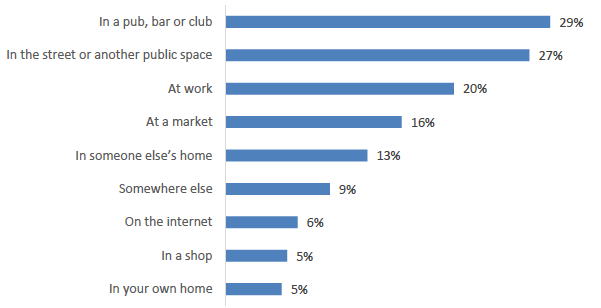
Base: Adults offered cigarettes/tobacco (100). Variable: QFKWHR.
Around three-in-five adults thought that the selling of fake and smuggled goods was common across Scotland, compared to just under one-in-five adults when they were asked the same question about their local area.
In a similar way to when respondents are asked about their perception of the extent of crime in their local area and across Scotland, respondents were more likely to think that the selling of fake and smuggled goods was more common across Scotland as a whole (60%) rather than in their local area (19%). Most believed that there had been no change in the selling of fake or smuggled goods over the last year in their local area (66%), while 13% thought it was more common and 7% said it was less common than a year ago.
Contact
Email: scjs@gov.scot
There is a problem
Thanks for your feedback